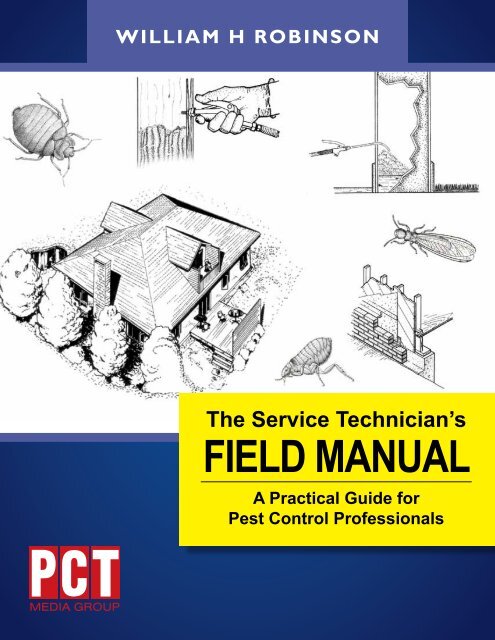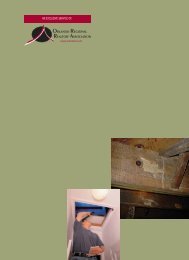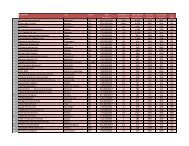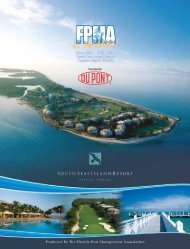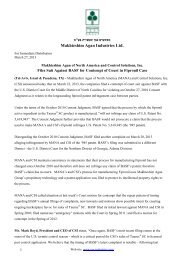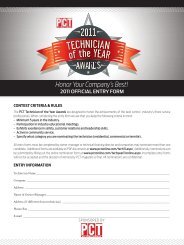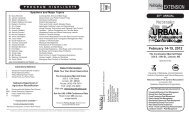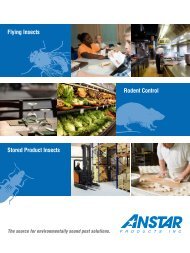table of contents - Pest Control Technology
table of contents - Pest Control Technology
table of contents - Pest Control Technology
Create successful ePaper yourself
Turn your PDF publications into a flip-book with our unique Google optimized e-Paper software.
William H Robinson<br />
The Service Technician’s<br />
Field MAnuAl<br />
A Practical Guide for<br />
<strong>Pest</strong> <strong>Control</strong> Pr<strong>of</strong>essionals
TABLE OF CONTENTS<br />
ChApTEr pAgE<br />
1 The Next Generation Service Technician.................................................................................................... 7<br />
2 IPM: <strong>Pest</strong> Detection and Monitoring ..........................................................................................................11<br />
3 Non-Chemical <strong>Control</strong> Methods ................................................................................................................21<br />
4 Chemical Insecticides .....................................................................................................................................33<br />
5 Insecticide Formulations ...............................................................................................................................41<br />
6 Application <strong>Technology</strong> ..................................................................................................................................51<br />
7 Transfer <strong>of</strong> a Toxic Dose ...............................................................................................................................61<br />
8 Application Economics ..................................................................................................................................69<br />
9 Structural Wood and Urban Soil .................................................................................................................77<br />
10 Exterior and Interior Features .....................................................................................................................87<br />
11 Termite <strong>Control</strong> ..............................................................................................................................................97<br />
12 Wood-Infesting Insect <strong>Control</strong> ................................................................................................................. 113<br />
13 Structural Fumigation .................................................................................................................................. 125<br />
14 Indoor Insecticide Application .................................................................................................................. 131<br />
15 Outdoor Insecticide Application .............................................................................................................. 141<br />
16 Rodent <strong>Control</strong> ............................................................................................................................................ 149<br />
17 Insecticide Application Equipment ........................................................................................................... 165<br />
18 Equipment Repair and Maintenance ........................................................................................................ 177<br />
19 <strong>Pest</strong>icide Application Safety ....................................................................................................................... 191<br />
20 Measurements and Calculations ............................................................................................................... 201<br />
21 Additional Reading ....................................................................................................................................... 207<br />
Index ............................................................................................................................................................... 211
CHAPTER 1<br />
THE NExT GENERATION SERvICE TECHNICIAN<br />
Much is already expected <strong>of</strong> the Service Technician<br />
in pr<strong>of</strong>essional pest control, but the next<br />
generation will be expected to know more and<br />
do more. The greatest change will be on-the-job decision<br />
making: What is the pest? What are the conditions? What<br />
control method(s) should be used, if any? What are the<br />
expected results? And, what does the customer want or<br />
expect to happen? All this must be processed quickly and<br />
applied correctly.<br />
While Integrated <strong>Pest</strong> Management (IPM) was a good<br />
concept for pr<strong>of</strong>essional pest control, in time it simply<br />
came to define what was already practiced or practical for<br />
most household pests. It is still useful, but not relevant.<br />
<strong>Pest</strong> control delivered by the next generation <strong>of</strong> service<br />
technicians will be situation specific—the individual<br />
technician will be able (and expected) to choose the insecticide, the delivery system, and<br />
the amount and location <strong>of</strong> whatever control agent is used. All these decisions will be<br />
made after arrival and based on the conditions and the customer.<br />
Situational specific, an idea borrowed from Industrial <strong>Pest</strong> Management Specialist<br />
Bobby Corrigan’s concept <strong>of</strong> rodent control, will define the next generation <strong>of</strong> pest<br />
control service and the service technician—as well it should. Service technicians are (or<br />
can be) trained and capable <strong>of</strong> making decisions; modern application equipment can<br />
deliver precise amounts; and modern insecticides are effective at concentrations as low as<br />
0.01% and some rodenticides at 0.005%. The tools and the control materials are in place<br />
for the next generation <strong>of</strong> technicians to decide what to do with them.<br />
INSECTICIdES<br />
The finished concentration <strong>of</strong> insecticides has been getting lower and lower with<br />
each wave <strong>of</strong> new classes <strong>of</strong> chemicals. The first group <strong>of</strong> household insecticides had a<br />
distinct odor and dilutions <strong>of</strong> 1.0 to 1.5%, the low-odor pyrethroids crossed over the<br />
decimal point with dilutions <strong>of</strong> 0.1% and 0.2%, and now the no-odor diamides and<br />
neonicotinoids have gone another step lower with the added benefit <strong>of</strong> no toxicity to<br />
humans.<br />
A major change for the current generation <strong>of</strong> service technicians is the emergence<br />
<strong>of</strong> the Reduced Risk insecticides, the class <strong>of</strong> chemicals that, because <strong>of</strong> their structure,<br />
have no toxicity to vertebrates. Indeed, the product labels on some new insecticides<br />
carry no signal word, such as “warning” or “caution.” The next generation <strong>of</strong> technicians<br />
will know this to be standard for the insecticides they use: the concentration will be<br />
low, the efficacy will be high, the amount applied will be small, and the treatment sites<br />
will be few.<br />
EquIpmENT ANd dELIvEry SySTEmS<br />
Without specifically designed application equipment in the hands <strong>of</strong> knowledgeable<br />
technicians, insecticides and rodenticides can not reach the pest to do their part. Modern<br />
insecticides will likely become more effective at lower concentrations and amounts, but<br />
7
8<br />
Compressed air sprayer<br />
Needed now are the<br />
materials, the trainers,<br />
and training sessions<br />
to match the ability<br />
with which the next<br />
generation <strong>of</strong> technician<br />
was born.<br />
The Service Technician's Field Manual<br />
regardless <strong>of</strong> those qualities, they will depend on accurate delivery. To the residential<br />
and commercial customer, equipment is a visible signal <strong>of</strong> the technology they expect.<br />
Insecticides are odorless and applied to leave little or no visible residue, pr<strong>of</strong>essional<br />
equipment is the first signal <strong>of</strong> efficacy.<br />
The next generation service technician will have to grasp the reality <strong>of</strong> application<br />
economics. Designed into every sprayer, fogger, and bait gun is the capacity for a controlled<br />
delivery, and this must be clearly understood and utilized by the applicator. The costs <strong>of</strong><br />
new insecticides will be justified by their efficacy with limited application, but only if this<br />
combination is realized by the technician. The business side <strong>of</strong> pr<strong>of</strong>essionalism cannot<br />
wait for the next generation service technician to discover application economics; it will<br />
have to be taught.<br />
CuSTOmErS<br />
The next generation service technician will realize the influence that Internet access has<br />
on the relationship with customers. Various websites provide identification, information,<br />
and control methods, as well as the Material Safety Data Sheets (MSDS), and customers<br />
can have these before the first treatment.<br />
All <strong>of</strong> this would be beneficial, except online identifications are <strong>of</strong>ten wrong,<br />
biological information misinterpreted, and control methods dated or slanted. The<br />
technician has to avoid these same pitfalls.<br />
The next generation customer will invariably link successful pest control with<br />
knowledge, and knowledge with pr<strong>of</strong>essionalism. This is an ideal customer. They are<br />
most likely not at home during treatment, yet are concerned about exposure to pets,<br />
plants, toddlers, and allergic reactions. The dry cleaner will tag a stain that would not<br />
come out, the car repair shop will detail the work and return the worn part, the next<br />
generation service technician will leave behind details on what was treated, what actions<br />
to avoid, and what to expect in the coming days.<br />
TrAININg<br />
For the generation <strong>of</strong> service technician that is now ending, training and testing was<br />
dominated by pest biology and habits—the number <strong>of</strong> eggs laid, their food preferences,<br />
their foraging distance, and how many died during laboratory evaluations. For the next<br />
generation, technology is much more important, in fact crucial, for the development<br />
<strong>of</strong> pr<strong>of</strong>essional pest control. Development <strong>of</strong> sophisticated equipment and application<br />
methods will require more technical training and matching skills. This will not be filled<br />
by the current generation <strong>of</strong> trainers, training sessions, and materials.<br />
The long-accepted practice <strong>of</strong> on-the-job training for new technicians provides<br />
training on the art <strong>of</strong> pr<strong>of</strong>essional pest control from an experienced mentor, but little <strong>of</strong><br />
the science. Without more science and technology in the training, this industry will stall<br />
at the end <strong>of</strong> the runway.<br />
The next generation <strong>of</strong> service technician has been raised amid technology and<br />
change, cursors and flash drives, and an app for everything. They will look for this in the<br />
workplace and accept the challenge—want the challenge.<br />
Training economics will show that acquiring information costs time and money;<br />
on-site and <strong>of</strong>f-site training has to show a return on investment for the individual<br />
and the company. For too long training has escaped the scrutiny <strong>of</strong> pr<strong>of</strong>itability; for<br />
the next generation technician the costs will be weighed. Companies as a whole and<br />
individual service technicians responsible for their time-pr<strong>of</strong>it margins will evaluate<br />
training opportunities in economic terms and will conduct or participate in training<br />
if the information is more specific, and not simply more, and as long as the economic<br />
benefit exceeds the cost <strong>of</strong> getting it.
Chapter 1: THE NExT GENERATION SERvICE TECHNICIAN<br />
TEChNOLOgy<br />
Inspections, identifications, and<br />
applications by the next generation<br />
<strong>of</strong> service technician will be made<br />
or assisted by a small electronic<br />
hand device. Clipboards, graphs,<br />
and guessing will be replaced by<br />
electronic pictures, videos, and<br />
voice communication between<br />
technicians, managers, customers,<br />
and websites. On-the-job training<br />
will be more accurate, relevant, and<br />
repea<strong>table</strong>, because it can include a<br />
short video from the website <strong>of</strong> the pesticide or equipment manufacturer. Similarly, onthe-job<br />
questions and identifications can be directly answered by the branch manager or<br />
technical director.<br />
The performance <strong>of</strong> the next generation <strong>of</strong> technicians will be<br />
based on the collective strength <strong>of</strong> the technology used by the<br />
next generation <strong>of</strong> pest control companies.<br />
Inspections, identifications,<br />
and applications by the next<br />
generation <strong>of</strong> service technician<br />
will be made or assisted by a small<br />
electronic hand device.<br />
9
CHAPTER 2<br />
IPM: PEST DETECTION AND MONITORING<br />
Integrated pest management (IPM) programs are based on having information about the<br />
target pest, then making a decision on the control methods to use. Programs typically<br />
begin with collecting and identifying the pest, locating the infested harborages, and<br />
using chemical or non-chemical control methods. IPM programs continue on the basis<br />
<strong>of</strong> monitoring, with traps or direct observation.<br />
INTEgrATEd pEST mANAgEmENT<br />
IPM began in agriculture; it provided an economic basis for<br />
decisions to use chemical control on crops. The objective <strong>of</strong> IPM<br />
is to provide an effective and economically efficient approach to<br />
pest control. It is based on the concept <strong>of</strong> reducing the number<br />
<strong>of</strong> pests to a level that does not cause an economic decrease in<br />
yield. This is pest management and not pest elimination. In pest<br />
management programs a low level <strong>of</strong> pests and damage are tolerated.<br />
IPM is a logical approach for production agriculture because it places<br />
pesticide application on a need basis and not on a routine-spray basis.<br />
IPM in agriculture also includes biological (non-chemical) methods when<br />
they are effective and economical.<br />
The concept <strong>of</strong> reducing pesticide use and managing pest populations<br />
may be considered for household and structural pests. However, applying<br />
a traditional IPM philosophy <strong>of</strong> managing (not eliminating) pests such as<br />
cockroaches, fleas, bed bugs, termites, and rodents is not practical. The approach<br />
to pest infestations in schools, houses, hospitals, and food facilities must be<br />
elimination. <strong>Pest</strong>s in the living environment can not be reasonably managed or<br />
suppressed to a low number. This simply would not be accep<strong>table</strong> for health or<br />
aesthetic reasons. However, the integration <strong>of</strong> non-chemical methods into a pest control<br />
program can contribute to immediate and long-term solutions to pest problems.<br />
IPM is sometimes considered to be the use <strong>of</strong> only non-chemical methods (no<br />
insecticides). However, this is rarely the basis <strong>of</strong> a successful approach to a pest problem,<br />
and ignores the characteristics <strong>of</strong> modern household insecticides. Many <strong>of</strong> the current<br />
products and formulations have no vertebrate toxicity, and have been granted Minimum<br />
Risk and Reduced Risk status by the U.S. Environmental Protection Agency (EPA). The<br />
predators, parasites, and other biological methods that can be successful in agriculture<br />
have little or limited effect on household pests.<br />
INSpECTION<br />
A thorough visual inspection <strong>of</strong> the site is the basic starting point for pest control<br />
programs. It requires knowledge <strong>of</strong> the target pest and experience with residential<br />
buildings, food plants, health care, and hospital facilities. Inspections require training<br />
and experience, and they take time. However, the time spent on inspection may result in<br />
less time in control and a more effective and cost efficient program. Inspections should<br />
include:<br />
Environmental conditions. Consider all environmental features that can contribute to<br />
pest infestation or can influence prevention and control strategies:<br />
Checklist<br />
Inspection provides justification<br />
for chemical and non-chemical<br />
control methods, and a baseline<br />
for evaluating programs.<br />
11
12<br />
70% with<br />
the bed<br />
7% with<br />
baseboard<br />
Bed bug distribution<br />
20% with<br />
furniture<br />
The Service Technician's Field Manual<br />
• Indoors. Carpeting provides harborage for cat flea larvae and localizes their food after<br />
it drops from adult fleas feeding on house pets. The humidity <strong>of</strong> sink drains and<br />
garbage disposals attracts fruit flies, while the wet conditions and organic matter in<br />
bath drains provides the food for moth fly larvae.<br />
• Outdoors. Vegetation surrounding buildings provides the food source for aphids and<br />
other insects feeding on plant sap, and the honeydew from these insects is food for<br />
many ant species invading buildings. Branches <strong>of</strong> shrubs and limbs <strong>of</strong> trees that<br />
contact buildings provide a bridge for carpenter ants to forage for food and nest<br />
sites. Poor rainwater drainage around buildings can provide favorable conditions for<br />
subterranean termites; moisture-damaged wood can provide favorable conditions<br />
for carpenter ants.<br />
Distribution. Insect and rodent pests are not evenly distributed in the habitat; there are<br />
“focus points” where pest density is high. Inspections can reveal pest activity, and help to<br />
justify specific control methods.<br />
• Indoors. Bed bugs infesting hotel rooms and residential bedrooms are most<br />
concentrated at the bed (70%), in bedside furniture (20%), and behind baseboards<br />
(7%) adjacent to the bed. Flea larvae in carpeting are concentrated where the<br />
household pet sleeps or rests.<br />
• Outdoors. Overwintering boxelder bugs and Asian ladybird beetles gather on surfaces<br />
warmed by afternoon sun. Subterranean termite monitors are effective in soil where<br />
temperatures are consistent.<br />
Sanitation. Poor sanitary conditions can decrease the effectiveness <strong>of</strong> pest control<br />
programs. Improved sanitation will remove some <strong>of</strong> the food and harborage that<br />
contributes to pest survival and limits control methods. Household clutter can seriously<br />
limit the effectiveness <strong>of</strong> inspections for bed bugs and reduce the residual activity <strong>of</strong> liquid<br />
and dust insecticides. German cockroach infestations are influenced by the availability <strong>of</strong><br />
food and water, but mostly by water in the habitat. Females can live six weeks without<br />
food but only 12 days without water.<br />
Documentation. A complete pre-treatment inspection provides the opportunity<br />
to document and report conditions. Attention can be given to sanitation problems<br />
and other features that must be corrected, or at least considered, in the control<br />
program.<br />
Programs designed for food preparation and packaging facilities require<br />
carefully maintained written records. For these sensitive accounts, the initial and<br />
subsequent inspections must be recorded, along with the pesticides applied, the<br />
findings <strong>of</strong> monitoring traps, and the sanitation and structural improvements<br />
needed.<br />
dETECTION ANd mONITOrINg<br />
Detection is typically done with traps that capture larvae, nymphs, or adults. The<br />
efficiency <strong>of</strong> the detection method, such as feeding blocks for rodents or sticky traps for<br />
insects, depends on placement. Each must be placed where it will be encountered by<br />
foraging or dispersing pests.<br />
Trapping is commonly used to determine the presence <strong>of</strong> pests in the habitat prior
Chapter 2: IPM: PEST DETECTION AND MONITORING<br />
to control, to monitor control effectiveness after treatment, or to estimate the level <strong>of</strong> a<br />
pest infestation and the need for treatment or retreatment.<br />
Action Thresholds. Detection action thresholds serve as a component <strong>of</strong> IPM<br />
programs, with the goal <strong>of</strong> limiting the use <strong>of</strong> insecticides. This concept is based on<br />
initiating control when a specific number <strong>of</strong> pests is detected in the treatment area.<br />
In some IPM programs this number functions as a tolerance threshold or trigger for a<br />
control action. Thresholds may be based on the number <strong>of</strong> pests detected at one location<br />
or over time in several locations.<br />
• For household pests, the IPM concept <strong>of</strong> action thresholds has limited use. The tolerance<br />
number may be as low as one, because <strong>of</strong> the potential for the development <strong>of</strong> a large<br />
infestation—as in the case <strong>of</strong> cockroaches, or the potential for personal injury—as<br />
with spiders or stinging insects. The detection <strong>of</strong> any subterranean termite activity<br />
at the perimeter <strong>of</strong> a structure is usually considered to be a potential threat. For bed<br />
bugs, the presence <strong>of</strong> a single insect or the experience <strong>of</strong> a single bite is the trigger to<br />
begin control.<br />
Monitoring: Post-Treatment. Traps can help in the detection <strong>of</strong> infested harborages<br />
before treatment and serve as a monitor <strong>of</strong> pest activity after treatment. The goal <strong>of</strong><br />
monitoring in pest management is to document changes in the pest infestation following<br />
a control action, and to signal the need for further action.<br />
hOuSEhOLd ANd STruCTurAL pESTS<br />
Ants. Ant infestations are <strong>of</strong>ten indicated by the presence <strong>of</strong> winged adults indoors.<br />
Infestations can be monitored by using feeding stations baited with a non-toxic food,<br />
then, at regular intervals, counting the number <strong>of</strong> ants visiting each station. Checking<br />
monitoring stations at the same time each day can provide information on abundance<br />
and colony activity.<br />
The action threshold for ant control is determined by the tolerance level <strong>of</strong> the<br />
residents <strong>of</strong> a site. In IPM programs for schools, the action threshold for ants in classrooms<br />
and kitchens may be as low as one or two. Post-treatment monitoring is usually done<br />
by counting the number <strong>of</strong> complaints from building inhabitants, without regard to the<br />
ant species involved.<br />
most ant control programs start after a report <strong>of</strong> ants<br />
indoors. however, ants in buildings may also be non-infesting<br />
species that collect honeydew from insects on plants adjacent<br />
to the building.<br />
Bed Bugs. Bed bug infestations can be detected and monitored with:<br />
• Specially designed traps which typically utilize a combination <strong>of</strong><br />
a pheromone lure, heat, and CO 2 to attract adults and nymphs<br />
from the immediate area. The insects may be held by a glue board<br />
or a pit-fall feature <strong>of</strong> the trap. The traps serve to confirm the<br />
efficacy <strong>of</strong> control methods and monitor for re-infestations. They<br />
are effective in locations where bed bugs are actively seeking a<br />
Bed bug<br />
For occasional or seasonal<br />
pests, thresholds must be<br />
established within practical<br />
limits. It is impractical to expect<br />
that commercial and residential<br />
buildings will be free <strong>of</strong> all insects<br />
and spiders.<br />
Winged adult ant<br />
Sticky traps designed with 30°<br />
ramps and sides can be used to<br />
capture bed bugs. A ramp-based<br />
sticky trap acts as a pit-fall trap,<br />
with bed bugs falling onto the<br />
sticky surface when they crawl<br />
down or fall from the ramp.<br />
13
Inspection <strong>of</strong> a typical hotel<br />
room may take a skilled technician<br />
about 20 minutes, while an<br />
inspection by a detection dog may<br />
require 2 to 3 minutes.<br />
14<br />
Cockroach<br />
Fruit fly<br />
The Service Technician's Field Manual<br />
blood meal. Interceptor traps for bed bugs capture those that attempt to crawl up or<br />
down furniture legs.<br />
• Scent detection dogs have also been used effectively for inspection and detection <strong>of</strong><br />
bed bugs. A qualified dog is able to identify small numbers <strong>of</strong> live bed bugs, and<br />
can discriminate live bed bugs and viable eggs from empty egg shells and cast skins<br />
from a previous infestation. As with other pest-detection tools, scent detection has<br />
limitations and is not always definitive. Scent dogs rely on what they can smell, but<br />
sometimes the odor from bed bugs in the location is not available to the dog. The<br />
reasons for this usually include location <strong>of</strong> the bugs, air flow in the room, and room<br />
temperature.<br />
Cockroaches. Cockroach infestations can be monitored with sticky traps. Rectangular<br />
traps with a low pr<strong>of</strong>ile can be placed under cabinets and kitchen appliances—out <strong>of</strong><br />
public view but close to potential harborages. A 30°-angle entrance ramp to the sticky<br />
surface significantly increases trap catch. Fewer cockroaches escape these traps, and they<br />
are capable <strong>of</strong> securing adults and nymphs.<br />
It is a common misconception that the infested harborage is<br />
in the opposite direction the captured cockroaches are facing<br />
in the trap. This assumes that cockroaches walked in a straight<br />
line from the harborage to the trap, which is unlikely.<br />
It is recommended that traps be placed flush against surfaces, as those placed just 3/4<br />
inch from walls catch about half as many cockroaches as those placed flush against them.<br />
Monitoring in residential and commercial facilities is usually done with two to five traps,<br />
which samples about 5% <strong>of</strong> the infestation in each 24-hour interval.<br />
Dust Mites. The presence and level <strong>of</strong> infestation <strong>of</strong> dust mites can be determined by<br />
several methods, including vacuuming sections <strong>of</strong> carpeting or using a lint roller on floor<br />
surfaces. The presence <strong>of</strong> dust mites can sensitize humans and cause asthma, rhinitis, and<br />
dermatitis.<br />
Action thresholds for programs to reduce mite allergens are difficult to establish.<br />
There is a range <strong>of</strong> human sensitivity to dust mite allergens, and controls may be short<br />
lived. Mites can re-infest from other locations, including <strong>of</strong>fice buildings, automobile<br />
seat covers, and clothing. Dust mite populations in summer can be as much as seven<br />
times greater than in winter. To prevent asthmatic symptoms or relieve an existing<br />
response to dust mites, the threshold limit is 100 mites per gram <strong>of</strong> dust.<br />
Flies. The most troublesome indoor fly pests are the red- and dark-eyed fruit flies, and<br />
phorid flies. Locating the source or breeding site for these small flies can be achieved by<br />
considering the habits <strong>of</strong> the adults and larvae.<br />
• Red- and dark-eyed fruit flies. The red-eyed fruit fly is usually found in residential<br />
and restaurant locations; it breeds in decaying fruit and garbage. This is the species<br />
that hovers over alcohol drinks and humid sinks. The dark-eyed fruit fly is found in<br />
commercial kitchens and breeds in rich, decaying organic matter. It rests on walls<br />
and ceilings and does not hover over food. Detecting and eliminating the breeding<br />
site will eliminate ongoing infestations.
Chapter 2: IPM: PEST DETECTION AND MONITORING<br />
Female fruit flies prefer to be in humid locations, such as sinks,<br />
and areas with vege<strong>table</strong> and fruit odors, such as garbage, but<br />
these are usually not their primary breeding sites.<br />
• Phorid flies. These small flies are associated with sewage and other organically rich<br />
substrates. Their appearance in large numbers is usually an indication <strong>of</strong> a break or<br />
failure in a drain pipe. Flies coming through floor drains may be an indication that<br />
there is a break in the sewer line. When there is an infestation in a septic tank, there<br />
may be large numbers <strong>of</strong> adult flies in bathrooms.<br />
Termites. Detection <strong>of</strong> termite infestations relies on visual inspections. For drywood<br />
termites this may be kick-out holes and granular frass. For subterranean termites it may<br />
be mud tubes on masonry walls or live termites in ground detectors.<br />
• Ground detectors. Termites around a structure are usually detected using wood stakes<br />
or other cellulose food sources placed in the ground. The length <strong>of</strong> the wood stake or<br />
plastic station is designed to intercept termite species that tunnel close to the surface<br />
and species that tunnel deeper in the soil. Once the food source is encountered by<br />
foraging termites, others from the colony will be recruited. Periodic inspection <strong>of</strong><br />
monitors will reveal termites in the above-ground food source.<br />
In-ground detectors can be installed any time <strong>of</strong> the year. Subterranean termites<br />
<strong>of</strong>ten remain active during winter and may feed in moist soil where the temperature<br />
is 40°F or higher. However, termites are more active in spring and fall, when soil<br />
moisture and temperatures are high. Soil in sheltered and shaded locations around<br />
buildings can have extended periods <strong>of</strong> moisture, and it may also be protected from<br />
seasonal temperature extremes. In open areas, soil moisture is usually low, especially<br />
in summer. Dry, hot soil is not a favorable foraging site for subterranean termites.<br />
Termite control programs typically include installation<br />
and maintenance <strong>of</strong> detection stations around and within<br />
crawlspaces <strong>of</strong> treated structures and at perimeter locations.<br />
• Swarmers. The emergence <strong>of</strong> a large number <strong>of</strong> winged swarmer termites inside a<br />
structure or around the outside is an indication <strong>of</strong> an infestation. A swarm indicates<br />
the presence <strong>of</strong> a colony that has been developing for many years. In general, the<br />
number <strong>of</strong> swarmers is proportional to the size <strong>of</strong> the colony. Most subterranean<br />
termite colonies produce swarmers by the time they are five years old, but large<br />
swarms usually don’t occur until the colony is eight to 10 years old. Formosan<br />
termite colonies may not produce swarmers until the colony is about 15 years old.<br />
Drywood termite colonies produce swarmers after about three years <strong>of</strong> development.<br />
• Electronic detectors. Electronic tools can detect the elevated temperature and humidity<br />
that indicate the presence <strong>of</strong> termites and carpenter ants. Detection radar devices<br />
show the extent <strong>of</strong> activity and the direction from which the termites traveled to get<br />
to a particular point. This may permit detection <strong>of</strong> the entry point and the source<br />
<strong>of</strong> the infestation.<br />
Thermal imaging cameras detect heat radiation. They process the heat <strong>of</strong> infrared<br />
light and display it on a screen. The higher the object’s temperature, the brighter the<br />
Phorid fly<br />
Phorid flies are distinguished by<br />
the shape <strong>of</strong> their legs and wings:<br />
the legs are long and slender, and<br />
the wings have few veins.<br />
Wood<br />
stake<br />
Cover<br />
ground detector<br />
Food<br />
source<br />
Bracket<br />
Detectors can be positioned at<br />
the edge <strong>of</strong> the liquid-treatment<br />
zone, where they can monitor the<br />
building perimeter and discourage<br />
disruption <strong>of</strong> treated soil.<br />
15
16<br />
Termite<br />
detection<br />
Adult beetles emerge from May to<br />
early July, so marking the surface<br />
<strong>of</strong> infested areas to determine<br />
activity should be done in late fall<br />
or winter.<br />
Monitor<br />
The Service Technician's Field Manual<br />
Ground<br />
stake<br />
image is on a screen. These cameras can locate termite risk areas but may<br />
not confirm the presence <strong>of</strong> small numbers <strong>of</strong> termites.<br />
• Moisture meters. Wood moisture content is useful in establishing the<br />
presence <strong>of</strong> conditions sui<strong>table</strong> for decay fungi and subterranean termites.<br />
The resistance-type moisture meter measures the electrical resistance<br />
between two pins inserted into the wood. These meters are reliable in<br />
the moisture content range <strong>of</strong> 7% to 27%. The number indicated on the<br />
meter scale represents the moisture content <strong>of</strong> the piece to the depth <strong>of</strong><br />
the pin electrodes. Non-destructive moisture meters (so called because<br />
they do not insert pins in the wood) are based on measurements <strong>of</strong> the<br />
impedance <strong>of</strong> low-frequency signals transmitted into the wood.<br />
• Detection dogs. Termite-detection dogs can locate active infestations<br />
<strong>of</strong> subterranean termites. Dogs can detect small numbers <strong>of</strong> termites<br />
in wood behind walls and in inaccessible areas. Their effectiveness as detection<br />
tools has limits, but the combination <strong>of</strong> a dog and an experienced technician is an<br />
effective and commonly used strategy.<br />
• Fluorescent markers. Termiticide dust formulations can have the added feature <strong>of</strong><br />
fluorescence. Termite workers that have eaten the cellulose bait can be detected<br />
by a yellowish glow using ultraviolet light. This permits tracking <strong>of</strong> termites that<br />
have been exposed to the dust, and possibly determining if those found in close<br />
proximity to the treated structure are from the same colony as termites previously<br />
exposed to the dust.<br />
Wood-infesting Beetles. Wood-infesting beetles can be detected by:<br />
• Exit holes in the surface <strong>of</strong> wood. However, the presence <strong>of</strong> holes, or even frass<br />
coming from holes, is not positive evidence <strong>of</strong> an active infestation. Exit holes<br />
persist long after all the larvae complete development or have been killed with<br />
an insecticide treatment. Frass may be jarred from feeding tunnels and fall from<br />
emergence holes. Covering the wood surface with a thin coat <strong>of</strong> paint will identify<br />
the old and reveal new emergence holes produced the following spring. In areas<br />
with only a few emergence holes, each can be individually marked.<br />
• Chewing sounds. Full-grown, old-house-borer larvae can be heard feeding in<br />
sections <strong>of</strong> structural wood, such as wall-framing studs or floor or attic joists.<br />
However, this sound can also be confused with scratching or gnawing sounds<br />
made by mice. Several longhorned beetle species infest pine firewood, and their<br />
feeding can also be loud and distinctly heard.<br />
powderpost beetle larvae can not be heard feeding in wood;<br />
these larvae are too small to produce an audible sound.<br />
• Structural damage. Establishing an action threshold for anobiid powderpost beetles<br />
in pine framing is difficult. Infestations that result in as many as 70 emergence<br />
holes per square foot do not significantly weaken the wood. At this density <strong>of</strong><br />
emergence holes, the modulus <strong>of</strong> rupture can be reduced 31% to 37% and the


